Serving 682 students in grades 6-8, Woodrow Wilson Middle School ranks in the bottom 50% of all schools in Virginia for overall test scores (math proficiency is bottom 50%, and reading proficiency is bottom 50%).
The percentage of students achieving proficiency in math is 38% (which is lower than the Virginia state average of 54%). The percentage of students achieving proficiency in reading/language arts is 63% (which is lower than the Virginia state average of 69%).
The student:teacher ratio of 14:1 is equal to the Virginia state level of 14:1.
Minority enrollment is 59% of the student body (majority Black), which is higher than the Virginia state average of 56% (majority Black and Hispanic).
Quick Stats (2025)
- Grades: 6-8
- Enrollment: 682 students
- Student:Teacher Ratio: 14:1
- Minority Enrollment: 59%
- Overall Testing Rank: Bottom 50% in VA
- Math Proficiency: 38% (Btm 50%)
- Reading Proficiency: 63% (Btm 50%)
- Science Proficiency: 56% (Top 50%)
- Source: National Center for Education Statistics (NCES), VA Dept. of Education
Top Rankings
Woodrow Wilson Middle School ranks among the top 20% of public schools in Virginia for:
Category
Attribute
Percent Eligible For Free Lunch
School Overview
Woodrow Wilson Middle School's student population of 682 students has grown by 20% over five school years.
The teacher population of 49 teachers has grown by 36% over five school years.
Grades Offered
Grades 6-8
(offers virtual instruction)
(offers virtual instruction)
Total Students
682 students
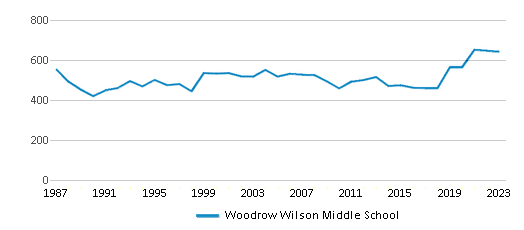
Gender %
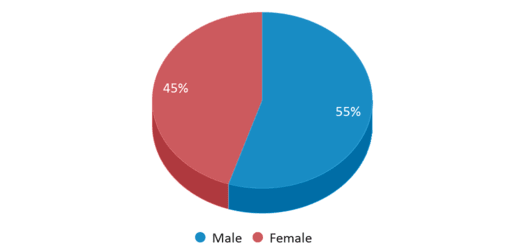
Total Classroom Teachers
49 teachers
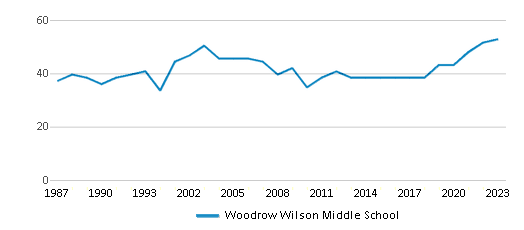
Students by Grade

School Rankings
Woodrow Wilson Middle School ranks within the bottom 50% of all 1,792 schools in Virginia (based off of combined math and reading proficiency testing data).
The diversity score of Woodrow Wilson Middle School is 0.70, which is less than the diversity score at state average of 0.72. The school's diversity has stayed relatively flat over five school years.
Overall Testing Rank
#1268 out of 1792 schools
(Bottom 50%)
(Bottom 50%)
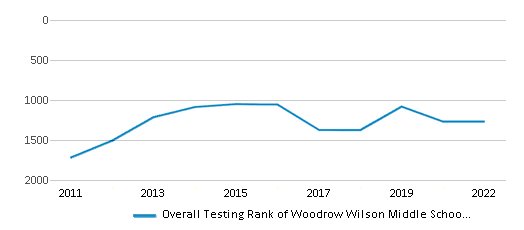
Math Test Scores (% Proficient)
(20-21)38%
54%
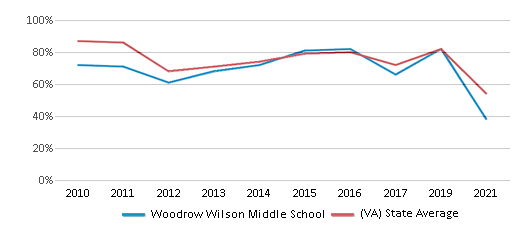
Reading/Language Arts Test Scores (% Proficient)
(20-21)63%
69%
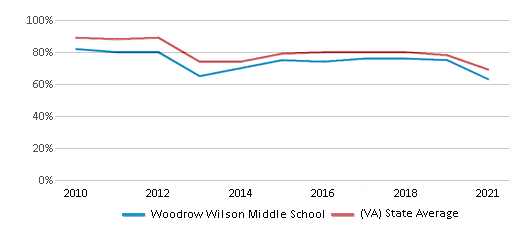
Science Test Scores (% Proficient)
(20-21)56%
59%
Student : Teacher Ratio
14:1
14:1

American Indian
n/a
n/a
Asian
5%
8%
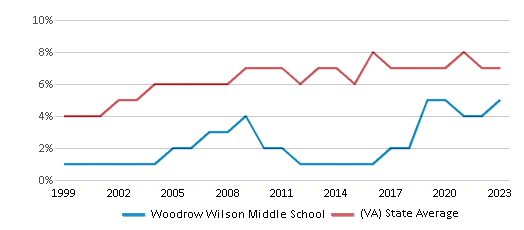
Hispanic
18%
19%
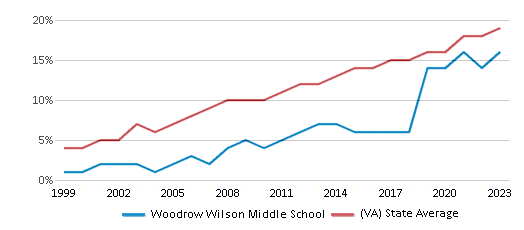
Black
32%
22%
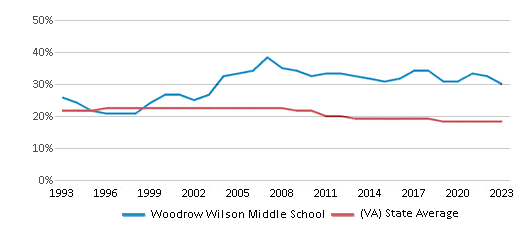
White
41%
44%
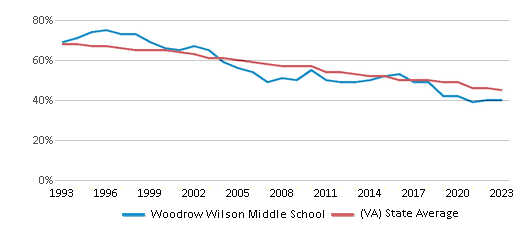
Hawaiian
n/a
n/a
Two or more races
4%
7%
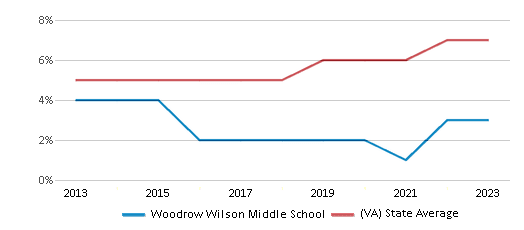
All Ethnic Groups
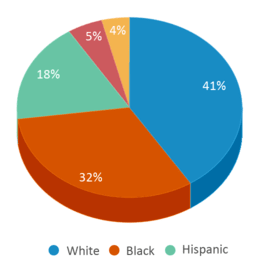
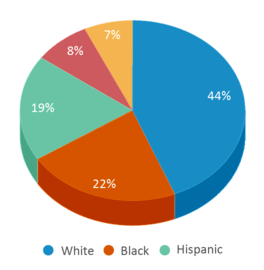
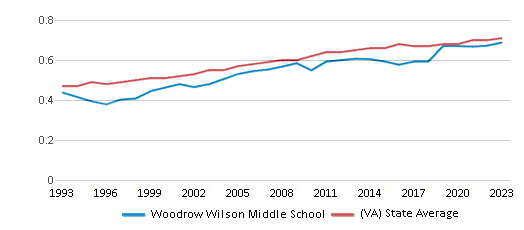
Eligible for Free Lunch
99%
55%
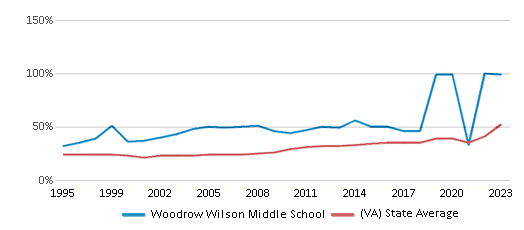
Eligible for Reduced Lunch (20-21)
4%
6%
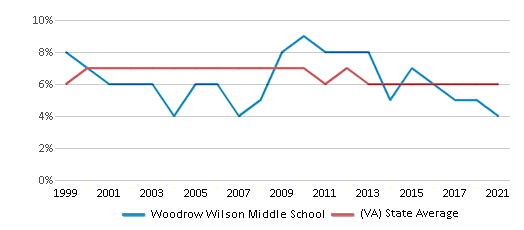
School Statewide Testing
School District Name
Source: National Center for Education Statistics (NCES), VA Dept. of Education
Profile last updated: 02/09/2025
Frequently Asked Questions
What is Woodrow Wilson Middle School's ranking?
Woodrow Wilson Middle School is ranked #1268 out of 1,792 schools, which ranks it among the bottom 50% of public schools in Virginia.
What schools are Woodrow Wilson Middle School often compared to?
Woodrow Wilson Middle Schoolis often viewed alongside schools like James Madison Middle School, Addison Aerospace Magnet Middle School by visitors of our site.
What percent of students have achieved state testing proficiency in math and reading?
38% of students have achieved math proficiency (compared to the 54% VA state average), while 63% of students have achieved reading proficiency (compared to the 69% VA state average).
How many students attend Woodrow Wilson Middle School?
682 students attend Woodrow Wilson Middle School.
What is the racial composition of the student body?
41% of Woodrow Wilson Middle School students are White, 32% of students are Black, 18% of students are Hispanic, 5% of students are Asian, and 4% of students are Two or more races.
What is the student:teacher ratio of Woodrow Wilson Middle School?
Woodrow Wilson Middle School has a student ration of 14:1, which is equal to the Virginia state average of 14:1.
What grades does Woodrow Wilson Middle School offer ?
Woodrow Wilson Middle School offers enrollment in grades 6-8 (offers virtual instruction).
What school district is Woodrow Wilson Middle School part of?
Woodrow Wilson Middle School is part of Roanoke City School District.
School Reviews
5 1/8/2021
This is a good school with good teachers and we found the new principal to be very dedicated and thoughtful.
1 3/27/2020
The squeaky wheel really does get the grease. It effectively makes everyone know what it needs. When it comes to your children's education, and safety, sometimes you have to be the squeaky wheel. In the past parents often accepted that the school officials were doing everything right, equally for all, and to the best of their abilities. Even when a school's intentions are the best parents may still need to play an important role as supporters, cheerleaders and, yes, watchdogs. Parents who understand their power can play a huge part in the quality of their community schools and the education of their children. This new model of parental involvement creates a partnership with the schools to help them improve, hold them accountable, and set high expectations for achievement, programs, and facilities.
Review Woodrow Wilson Middle School. Reviews should be a few sentences in length. Please include any comments on:
- Quality of academic programs, teachers, and facilities
- Availability of music, art, sports and other extracurricular activities
Recent Articles

What Is A Charter School?
Explore the world of charter schools in this comprehensive guide. Learn about their history, how they operate, and the pros and cons of this educational innovation. Discover key facts about charter schools, including admission policies, demographics, and funding, as well as what to look for when considering a charter school for your child.

10 Reasons Why High School Sports Benefit Students
Discover the 10 compelling reasons why high school sports are beneficial for students. This comprehensive article explores how athletics enhance academic performance, foster personal growth, and develop crucial life skills. From improved fitness and time management to leadership development and community representation, learn why participating in high school sports can be a game-changer for students' overall success and well-being.

February 05, 2025
Understanding the U.S. Department of Education: Structure, Impact, and EvolutionWe explore how the Department of Education shapes American education, from its cabinet-level leadership to its impact on millions of students, written for general audiences seeking clarity on this vital institution.





